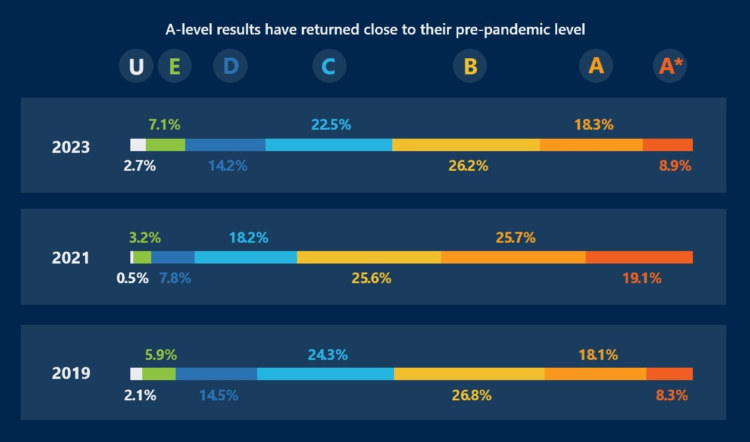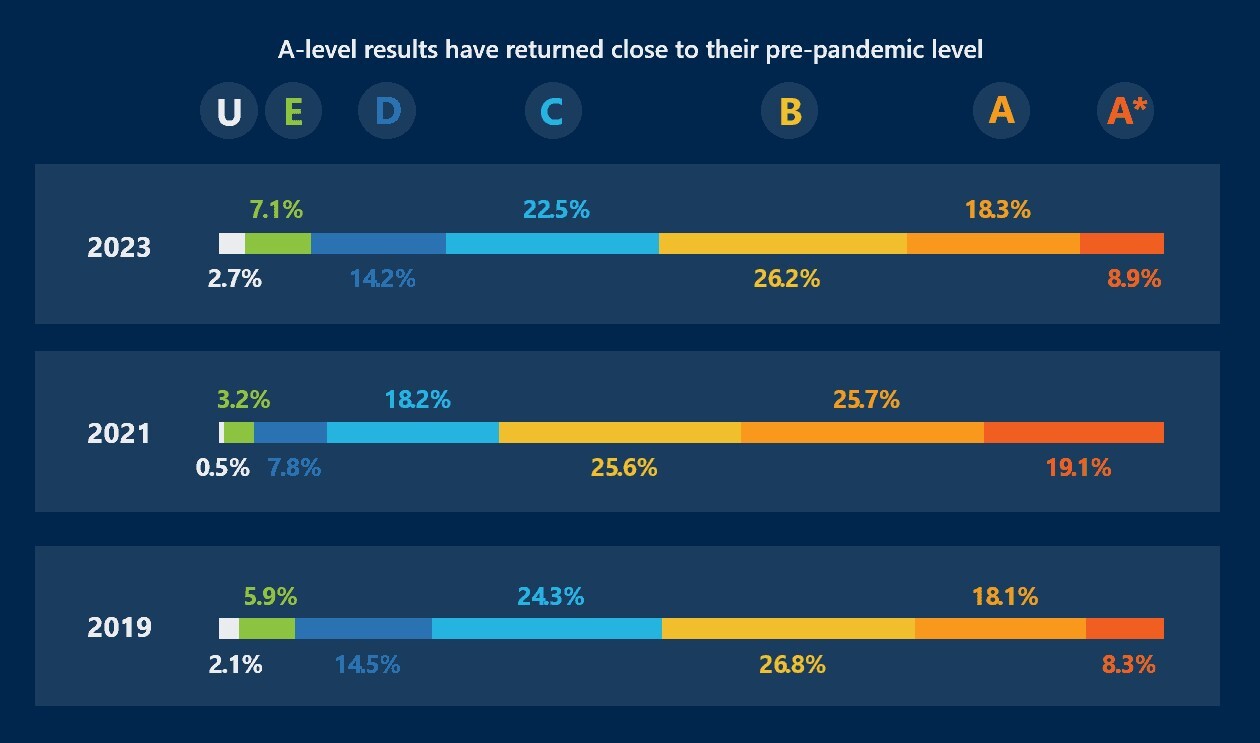Idea In Brief
Results are out
We have been fortunate to work with an array of universities across the UK on recruitment strategies. We are pleased to explore how we think the A-level results and international application numbers will impact recruitment activities at UK universities.
Strategy rethink
Many universities must rethink their recruitment strategy. Competition for students with strong results is more intense than ever. Universities must be realistic about where they can compete and who they are targeting with what offers.
Meeting student interests
Universities must adapt their course portfolio to meet students’ changing interests. Universities must meet these changes in the courses they offer and their pedagogy. This requires agility and simplicity in course design.
A Thursday in mid-August was a day of relief, disappointment and many emotions in between for hundreds of thousands of graduating school students across the UK. The release of the A-level results was a big moment in the lives of students, made even more significant by the fact the pandemic meant some had not previously sat formal exams.
It was also a big moment for UK universities, which are now grappling with the impact of A-level results and the number of international applications on their recruitment strategies for domestic and international students.
The A-level results showed a decline in student performance on the previous year, bringing results close to the level they were at before the pandemic. This decline caught some universities by surprise – many found their offers were too high and several Russell Group universities went into clearing for the first time to top up their recruitment pipeline.


So what do the latest results mean for universities in their quest to recruit students?
We have been fortunate to work with an array of universities across the UK on recruitment strategies. In this article, we are pleased to share four insights exploring how we think the A-level results and international application numbers will impact recruitment activities at UK universities.
1. Many universities must rethink their recruitment strategy
Demand for university courses continues to grow. This application cycle involved the second-highest number of applications from UK 18-year-olds, and a year-on-year increase in international applications for undergraduate courses. But the reduction in A-levels also forced many universities into clearing.
What does this mean for universities?
Competition for students with strong A-level results is more intense than ever. Universities must be realistic about where they can compete, who they are targeting with what offers, and how they can ensure their approach is up to date and will generate results.
What does our experience show?
When it comes to focusing your recruitment efforts, it is essential to engage with your target market – typically current university students, sixth form and college students, parents, and careers advisers. We worked with a post-92 university to figure out where its marketing could have the greatest impact. Through our survey and focus groups with people in the target market, the university could zero in on the people it was trying to reach, helping it to improve its admissions process and marketing performance.
2. Universities must demonstrate their value to students
This was the busiest clearing on record. Some 15 per cent of UK 18-year-old students were placed in clearing, with a smaller number of available spaces (22,000) than previous years. The proportion of students who got a place at their first choice was lower than last year but remained high, at 79 per cent compared with 74 per cent in 2019.
What does this mean for universities?
The implications depend on which part of the market a university is competing in. Students are still more likely to achieve their first choice than prior to the pandemic, and if they are using clearing, need to make quicker decisions on results day.
This means universities with lower league table rankings must clearly convey their student value proposition during marketing activities, including open days, the application process itself, and clearing. Universities in the mid-upper reaches of league tables face a more complex challenge – some highly ranked institutions have used clearing to recruit students who have existing offers, leading to a sudden and unexpected gap in recruitment for mid-ranked institutions.
Universities must stand out from competitors to attract students as a first choice and during clearing, and rapidly adapt in a dynamic recruitment environment.
What does our experience show?
Data can give universities an edge. Through analysing rankings, pricing, scholarships and skills data they can more readily identify opportunities and vulnerabilities. We worked with a Russell Group university to use a wide array of data to inform a comprehensive recruitment strategy built on a clear value proposition by target student segments, which has helped deliver 10 per cent growth in student numbers in a year.
3. Universities must adapt their course portfolio to meet students’ changing interests
This year there was a record number of applications for computing courses, up 33 per cent on 2021. Computing is now the seventh most popular course in the UK. Other courses are becoming less sought – applications for education and subjects allied to medicine have dropped at least 9 per cent.
What does this mean for universities?
Students’ interests are changing, reflecting wider social and technological changes – think new advances in artificial intelligence (AI) or growing climate change visibility – and economic trends in major disciplines – like reduced interest in nursing and teaching due to uncompetitive salaries. Universities must meet these changing needs, both in the courses they offer and their pedagogy. This requires agility and simplicity in course design to ensure the offer is relevant to and easily understood by prospective students.
What does our experience show?
Universities need to be deliberate in their course architecture. A complex portfolio of courses can overwhelm prospective students and lead to many courses with low enrolments. We helped a Russell Group university redesign its entire programme portfolio. By consulting widely with academics, professional services and students, we could design a new, future-ready portfolio.
4. Universities must provide the right offer for different international student cohorts
Among international students, demand from China is falling but demand from other parts of Asia is rising. While China remains the largest overseas source of undergraduate students, acceptances for UG students from India, the UAE and Turkey are already higher than last year, despite the recruitment cycle not yet being complete.
What does this mean for universities?
Many universities have teams to recruit international students from China, with a lesser presence in other markets. As source countries change, universities need to diversify their presence outside China, India and other large established markets. They must also tailor their pricing approach to markets that are more price sensitive.
What does our experience show?
A price benchmarking tool can help universities understand the pricing decisions faced by international students. We developed a competitive price benchmarking tool to support a university to develop a new international strategy. Along with staff consultations, market research and a trend map, the tool helped the university to meet its ambitious international recruitment targets and improve the experience of its international students. This university has almost doubled its international intake in one year.
Investment is essential to achieving sustainability
The bottom line is that universities can improve their recruitment performance with targeted and specific investments in good data, strategy and capability. Technology such as workflow automation tools is beginning to be deployed across the sector to accelerate offer turnaround times, which is critical in such a competitive environment. But most universities can improve their recruitment performance with even simpler solutions across their admissions and recruitment functions.
The latest release of A-level results, and the recruitment cycle that follows, is making clear how critical those investments will be to the sustainability of UK institutions. Institutions that fail to invest risk being left behind.
Get in touch to explore how we can support you to strengthen your recruitment efforts.
Connect with Oliver Jawara on LinkedIn.


